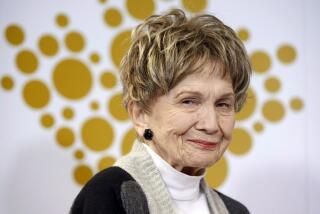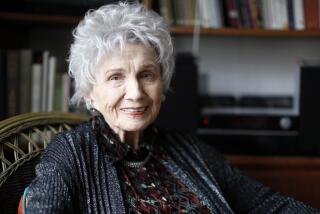Mysteries and Revelations
Canadian writer Alice Munro’s masterful 10th collection of stories, “Hateship, Friendship, Courtship, Loveship, Marriage,” proves again that she is a writer to cherish. Munro, who turned 70 this year, has throughout her career focused on a particular region--rural southwestern Ontario--as well as on the cities of Vancouver and Toronto. Her world is not very different from any small town or village with farmland, lakes and rivers, shady streets and big brick houses, insular rules and rituals. “Who Do You Think You Are?,” her 1978 collection, is a universal subtext: Every community watches and listens, gossips and passes judgment.
Over the years since her first collection, “Dance of the Happy Shades,” was published in 1968, the sheer spaciousness of Munro’s storytelling, her gift for surprising us with the truth about ourselves, has transcended national boundaries and the limits of regionalism. Which is why we have come to embrace her as a major author writing in English on the strength of her short fiction.
In the nine stories in her new collection, Munro works a rich new vein of retrospection, following the meandering stream of memory as it flows to and fro, revealing long-buried nuggets and unexpected gaps, reversals and corrections. The unwieldy title of the collection comes from a girlhood game in which you write a boy’s name and your own, cross out the duplicated letters, count the remaining ones and tick them off on your fingers to find out how you two will fare: Hateship, friendship, courtship, loveship, marriage. Munro considers all of these permutations and then some in these stories of the relationships of women to men, to their younger selves and to the vibrant web of the community.
Characteristically, Munro’s stories start abruptly, in plain, even blunt language, build momentum, then plunge into unexpected territory. ‘Nina had been playing tennis in the late afternoon, on the high school courts,’ she writes in the opening lines of “Comfort.” Nina heads home after winning the game to discover that her husband, who is suffering from Lou Gehrig’s disease, has committed suicide. The year before, he had been forced out of his job teaching high school science in a dispute with students and parents who wanted him to give equal time to creationism.
The murky ripples of this small-town controversy spill over as Nina decides how to mark his passing. Her final decision is both complicated and facilitated by the undertaker, with whom she once had a mild flirtation.
“What is it really that you do?” she asks him at one point. With great delicacy, he offers her details of the embalming process.
By the time the story ends, Munro has touched upon most of the questions we face when faced with death. In “The Bear Came Over the Mountain,” Fiona is 70 and losing her memory. Her philandering husband finds a home where she can be taken care of but is told he must not visit for 30 days, at which point he gets his comeuppance. And yet, Munro leaves us pondering the unexpected pull of his love for Fiona.
“Queenie,” the least satisfying story in an otherwise superb collection, shows an older stepsister, Queenie, through the eyes of Chrissy, a country girl who goes to visit her in Toronto, hoping to find a life of romance and glamour. Instead, Queenie runs off, leaving her husband for another man, and Chrissy never sees her again. The ending--after Chrissy’s children are grown, her husband retired and after she has odd glimpses of a woman she thinks is Queenie--seems slight in comparison to the full-fleshed richness of the other stories.
The most astonishing story, “Family Furnishings,” begins simply. “Alfrida. My father called her Freddy. The two of them were first cousins.... One day they were out in the fields of stubble playing with my father’s dog....” Suddenly they heard bells pealing and whistles blowing, signaling the end of World War I: “The world had burst its seams for joy.”
The narrator tells the story of Alfrida, the career woman with “zing” who writes for the local newspaper’s women’s page and treats her to her first “ciggie-boo.” Alfrida takes up with a married man and moves to the city. The narrator ends up in college there, and Alfrida has her to lunch--a heavy meal of meat and vegetables “like Sunday dinners at home.”
Alfrida tells a family anecdote about how her mother had died of burns she got when a lamp exploded in her hands. Alfrida was kept from her bedside, told she wouldn’t want to remember her this way. “But you know what I said? ... I said, ‘She would want to see me.”’ The narrator takes note--this is a part of the familiar story she had never heard--and later writes a story about the incident. Years later, at her father’s funeral, the narrator meets a woman who tells her she is Alfrida’s daughter, given up at birth.
This woman also knows the anecdote about Alfrida’s day in the fields at the momentous end of the war. Alfrida’s daughter’s revelations are startling, if not surprising. More shocking is how well she knows the narrator. “[Alfrida] said you were smart, but you weren’t ever quite as smart as you thought you were,” she says.
So that’s what this story is about, you think. The family secret she had missed through all the years. But no. The story turns back on itself and Munro gives us an ending that takes the breath away. The narrator remembers the hours after her lunch years before with Alfrida. The narrator leaves Alfrida’s apartment early, saying she has to meet friends. But she is really headed off for a long walk and a cup of coffee in delicious solitude.
“Such happiness, to be alone ....To hear from the back of the shop the sounds of the ballgame that the man who had served me was listening to on the radio. I did not think of the story I would make about Alfrida--not of that in particular--but of the work I wanted to do, which seemed more like grabbing something out of the air than constructing stories. The cries of the crowd came to me like big heartbeats full of sorrows.... This was what I wanted, this was what I thought I had to pay attention to, this was how I wanted my life to be.”
What is this story about? The personal consequences of a shattering historic moment, the stubborn nature of secrecy and shame, the ruthlessness of the writer who uses private information as raw material for her art. The ironic gentleness of the older self’s relationship to the younger, the possibilities for continual revelation within the human condition, the mysteries of how a story works, the sheer deep and subtle joy of Munro’s life work.
This work encompasses more than a century of social upheaval--two world wars, the Great Depression, the fluctuations of the gender wars. Over the years Munro has absorbed the Zeitgeist and worked it with her own alchemy. Even some of her earliest stories are as fresh as if written yesterday. (Take a story she wrote in the 1950s, among those she has said she considered “exercise stories ... the work of a beginning writer.” “An Ounce of Cure” is the wry tale of a teenage girl’s first experience with alcohol. While baby-sitting, she slugs down two glassfuls of whiskey; later she remembers “lying on the bathroom floor looking sideways at the little six-sided white tiles, ... seeing them with the brief broken gratitude and sanity of one who has just been torn to pieces with vomiting.” The details are precise, hilarious.)
Munro has avoided literary fads and followed her own circuitous path, capturing the nuances of ordinary lives with naturalistic grace. Her observations are as acute as the photographic mages of Dorothea Lange and Walker Evans. Her stories will be as enduring.
More to Read
Sign up for our Book Club newsletter
Get the latest news, events and more from the Los Angeles Times Book Club, and help us get L.A. reading and talking.
You may occasionally receive promotional content from the Los Angeles Times.








